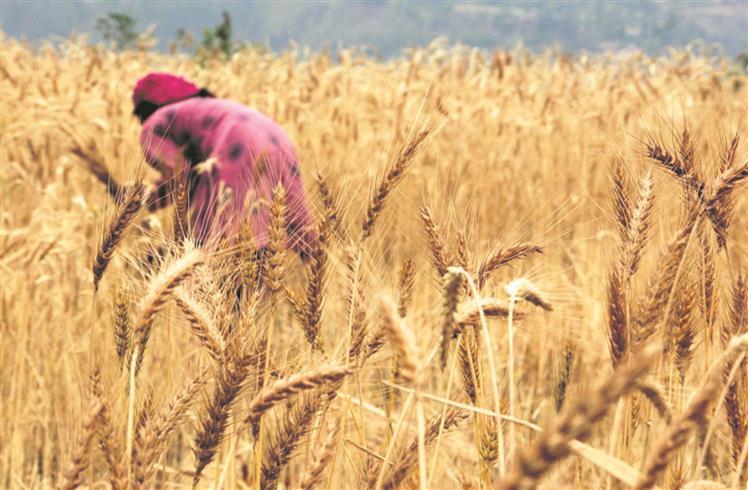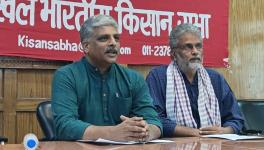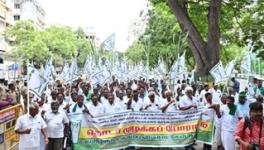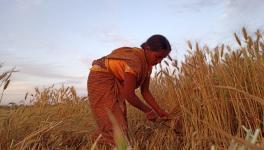India’s Wheat Fiasco!

Representational Image. Image Courtesy: Tribune India
The month of May seems to be the Narendra Modi Government’s favourite month for conjuring a crisis out of thin air. Exactly a year ago, it was the vaccine fiasco; this year, it is the wheat crisis. About a month ago, Modi, accustomed to the bombast of a Vishwaguru, told US president Joe Biden that India, a non-existent player in the global wheat trade, could play a role in feeding the world. A month later, that pipe dream lay in shreds as his government announced a ban on wheat exports. This is a story of utter mismanagement, of a piece with the reckless demonetisation of 2016, the mindless implementation of the Goods and Service Tax of 2107 and the policies pursued since the pandemic in 2020.
Vishwagurus do not ask when they do not know. This is exactly what led to the Modi Government’s flip-flop on wheat exports. Clearly, the decision to export was driven by a brainwave emanating from the Commerce Ministry, which suggested that India could take advantage of the surge in global wheat prices that actually started before the invasion of Ukraine early this year. If only the Vishwaguru had called Krishi Bhawan to ask what it thought of this brilliant idea; it may well have received a more sober assessment of the sudden desire to feed the world.
On May 13, the government announced a ban on wheat exports. Just how thoughtlessly this was done was revealed four days later when it was forced to issue a clarification stating that export orders already booked would be allowed. This was necessary because large consignments of wheat shipments destined for overseas markets were stranded at Indian ports such as Kandla. Latest indications suggest that about 4.5 million tonnes of wheat may already have been contracted for exports.
WHEAT OUTPUT CONCERNS
India’s wheat harvest is likely to be lower, much lower than previously estimated. The wheat output, initially estimated to be a bumper crop of 113.5 million tonnes, turned far less optimistic after the intense heat in March and April affected crop yields. In early May, the expected harvest was lowered to 105 million tonnes. Even more recent speculation, based on information sourced from the corridors of Krishi Bhawan, portrays an even more dismal picture; the harvest, in its most optimistic estimates, is now expected to be just between 98-100 million tonnes. This would be about 10% lower than last year’s wheat output, and it would be almost 14% lower than the bumper harvest that was expected earlier.
Meanwhile, egged on by the voluble Commerce Minister Piyush Goyal, and unmindful of the storm that was building, the Vishwaguru continued regardless. This thinking, based firmly on the ignorance of the actual state of the wheat harvest, was that the “additional” output this year would place India quite comfortably, enabling it to export about 5 million tonnes of wheat.
Soon after Modi made his promise to Biden, the Commerce Ministry went into overdrive. Goyal enthusiastically set the wheat export target at 10 million tonnes and even started talking about exporting even more, 15 million tonnes. The Commerce Ministry facilitated a deal with Egypt, the world’s biggest wheat importer, for wheat exports. In fact, just a day before the announcement of the ban, delegations to several countries were to leave, ostensibly to explore other markets, mostly in developing countries.
Meanwhile, as the harvested grain arrived in mandis, they were mostly mopped up by private trade. Since the marketing season commenced in April, only about 17.8 million tonnes of wheat had been procured by the Central and State agencies by May 10. The export drive had pushed up prices, and with the Union Government stubbornly unwilling to bid up prices above the Minimum Support Price levels (Rs. 2,015 per quintal), procurement has plummeted. Last year Central (mainly the Food Corporation of India) and State procurement agencies procured 43.34 million tonnes of wheat. This year’s target, originally set at 44 million tonnes, has been drastically reduced to 19.5 million tonnes. The Centre’s appeal to states to extend the procurement season is unlikely to result in any additional procurement. It is just too little, too late (see Chart 1).
It is striking that by May 10, the Food Corporation of India (FCI) has procured just 5.51% of all wheat procured by official agencies. Although the FCI’s share of procurement has been declining ever since Modi came to office in 2014, this is the lowest-ever level for the FCI’s wheat procurement operations (Chart 2).
TO EXPORT WHEAT OR NOT
Even before the war in Ukraine commenced, there were strong indications that global wheat output would be affected adversely in the major wheat-producing countries that generally have tradeable surpluses. There were indications that output in several major producing and exporting countries — the US, Russia, Australia, Canada and the European Union — would be significantly lower, leaving less available for wheat-deficit countries. In fact, Russia, one of the biggest exporters, announced an export tax on wheat exports in November 2021, well before the Ukraine crisis reached a flashpoint. All these factors provided a rare window of opportunity for a country like India to take advantage of rising wheat prices in the global market.
To a government that was committed to allowing an unfettered role for private trade in agricultural markets — illustrated by its stubborn pursuit of the three controversial farm laws, which it was forced to withdraw in the face of unprecedented opposition from the Indian peasantry — the decision to export wheat would appear to be logical. To Indian farmers, the situation offered a rare opportunity — after years of low output prices — to increase their incomes following the surge in prices. However, what is inexplicable is the Modi Government’s utter unwillingness to pay a higher price in order to ensure food security.
Sukhpal Singh of the Indian Institute of Management-Ahmedabad, now travelling in Punjab, told NewsClick that it is “extremely unlikely any wheat is left to be procured”. He pointed out that with the procurement season at its fag end, the Punjab Government had wound down the procurement process and shut the procurement centres by the time the Centre announced the ban on exports.
Sukhpal Singh avers that although the Government’s decision to export wheat “may not have been wrong in itself, it (the government) appears to have been focused on exports for far too long.” “The more sensible thing would have been to impose a minimum export price instead of completely banning exports,” he argued. Implicitly, this would have ensured that only better-quality were exported, leaving a surplus available for the domestic market.
In a situation where market prices had increased, especially because private trade had mopped up a larger share of a smaller harvest, it would have made sense for the Centre to announce an immediate increase in the price it was offering. This is exactly what the All India Kisan Sabha has demanded.
In a statement issued on May 17, the AIKS demanded a “bonus” of at least Rs. 500 per quintal. This, it argued, would not only compensate farmers for the crop losses they had suffered but also for the escalating cost of inputs, most significantly, fertilisers. It argued that such a bonus would have the advantage of not only providing relief to farmers but strengthening food security.
Deepak Johnson, Associate Fellow, Foundation for Agrarian Studies, Bengaluru, observed that the Indian peasantry, burdened by the rising costs of cultivation during the pandemic, has suffered additionally because of the disruptions in marketing channels. “This has depressed farmer incomes further,” Johnson said.
The Modi Government’s pig-headed stance of not offering a higher price, even as it claims to be committed to more wheat procurement, is a clear indication that it is unwilling to put its money where its mouth is.
“When the government realised that it was unable to procure enough wheat at MSP levels, it should have hiked the bonus in order to mop up whatever was needed,” says Sukhpal Singh. “This situation would not have arisen if the government had acted quickly,” he said. Extending the procurement season is not going to achieve anything, he added.
FOOD SECURITY CONCERNS
The immediate reason for the export ban has ostensibly been triggered by fears about whether there would be enough foodgrains available for distribution through not just the public distribution system but also the various special programmes that have assumed importance since the pandemic. Perhaps the only redeeming feature of the Modi Government’s response to the COVID-19 pandemic has been the expansion of schemes to deliver foodgrains.
As Chart 3 illustrates, total allocations of wheat from the Central Pool increased by an impressive 30% in 2020-21, followed by an additional increase of 42% in 2021-22 (offtake too increased by more than 30% in the two years).
The special programmes — the PM Garib Kalyan Anna Yojana and special schemes for migrant workers as well as Covid relief packages — accounted for more than 30% of ALL allocations in 2020-21 and 37% in 2021-22. There is a worry that the shortfall in wheat production and procurement may be used as an excuse to limit the continuation of these expanded programmes of support.
The provision of food security essentially has two components. The first is the most obvious objective of actually reaching foodgrains to people, particularly the more vulnerable. If anything, the significant expansion of distribution in the last couple of years highlights the prolonged neglect of India’s most vulnerable. The lingering effects of the pandemic require not just the continuation but further expansion of these provisions.
The other factor influencing food security are prices of foodgrains. A robustly functioning Public Distribution System that reaches a large section of the people has the effect of dampening open market prices; even those who cannot avail of all their requirements from the PDS find that the prices in the open market are generally lower because of the fact that there is “competition” from the publicly-run system.
R Ramakumar, who teaches at the Tata Institute of Social Sciences in Mumbai, points to an interesting fact that emerges from the latest inflation numbers (for April 2022) released recently. He points to the fact that rural inflation rates, as measured by the rural Consumer Price Index, are significantly lower in both Kerala and Tamil Nadu, both of which are regarded as having among the best-functioning public distribution systems in the country.
COUNTERING INFLATION
Quite apart from this, a significant aspect of the government’s intervention in the market, which has a bearing on foodgrain price levels, relates to the open market operations undertaken by the Food Corporation of India (FCI). The release of foodgrains from government stocks has the effect of cooling grain prices in the open market. Last year, for instance, the release of wheat in the open market through sales to private trade amounted to more than 7 million tonnes. This was a significant quantity; it was about 6% of the entire wheat harvest last year; as a proportion of the government’s entire allocation of wheat for all its programmes, it was almost 13%.
It would be alarmist to suggest that stock levels are dangerously low. As chart 4 illustrates, although wheat stock levels in May 2022 are about 43% lower than last year’s level, they are only about 8% lower than levels in May 2019. There is also the possibility of using rice as a substitute for wheat in allocations to states, which is unlikely to have severe consequences for food security. Madhura Swaminathan, Professor and Head of the Economic Analysis Unit at the Indian Statistical Institute, Bangalore, observes that since both rice and wheat have pan-Indian acceptability in the diets of most Indians, such a switch is unlikely to have serious repercussions for food security.
Although stock levels are not yet in jeopardy, the government’s ability to check the surge in wheat prices may be significantly undermined. This is because the government’s capacity to release wheat in the open market may be seriously undermined by the low procurement in the current year. The government’s ability to check such a surge in prices may be compromised, especially because private and speculative trade have captured the bulk of the wheat procurement in the current year.
As wheat prices surge, the scale of the open market operations needs to be expanded in order to bring prices under control. And, given the shortage of wheat, the government's ability to significantly influence market prices significantly through allocations for market operations may be compromised. Moreover, if wheat prices continue to increase sharply, the quantity of grain needed for open market operations to check prices may need to be significantly higher this year.
Ramakumar’s research on market arrivals of agricultural produce since the pandemic offers some insights into the role of private trade in overall procurement. His studies have revealed that the arrivals of wheat have been at least 20% lower than they ought to have been; the implication is that “informal” channels, possibly even large agribusiness ventures, are taking away a larger share of the output that may have been otherwise available for public procurement.
This has two important consequences in the current context. First, it means that public procurement has to account for a larger share of the produce, especially if the government has to be in a position to influence open market prices. More importantly, from the perspective of farmers, it means that the government has to offer higher — and more competitive — prices if it is serious about increasing procurement.
Chart 1: Procurement of wheat in rabi marketing season (million tonnes)
Chart 2: Share of FCI in wheat procurement in rabi marketing season (per cent)
Chart 3: Total allocations and offtake of wheat (in million tonnes)
Chart 4: Wheat stocks in Central Pool in May (2019-2022) (million tonnes)
Get the latest reports & analysis with people's perspective on Protests, movements & deep analytical videos, discussions of the current affairs in your Telegram app. Subscribe to NewsClick's Telegram channel & get Real-Time updates on stories, as they get published on our website.
























